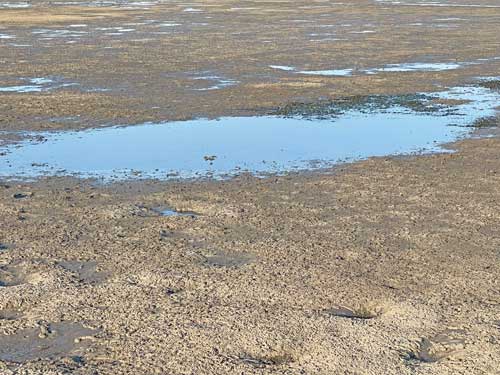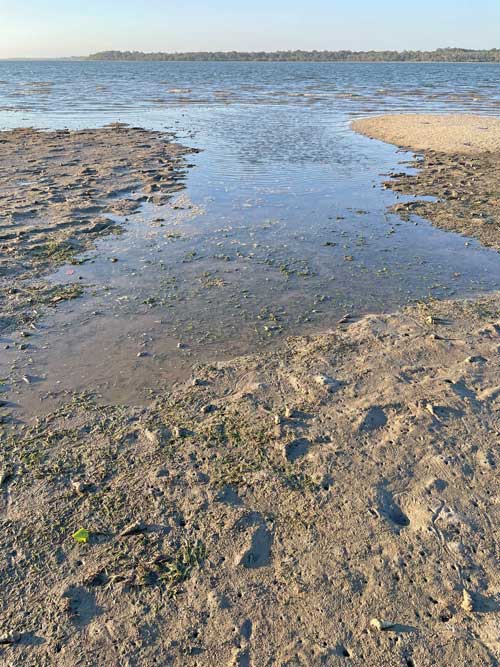Saltwater river and estuary systems are loaded with structure, bait and a wide variety of fish species, including bread and butter basics like whiting, bream and flathead, and more exotic species such as snapper, trevally and grunter.
When exploring new systems or hitting my local waters, one key structure that I like to target is saltwater yabby beds.
In this article I will break down yabby-bed fishing and discuss the key tides, techniques and gear I use when fishing soft plastics around these productive areas.

Saltwater yabbies
If bait fishing is your thing, then saltwater yabbies are readily accessible in many systems and can be gathered on the lower stages of the tide using a bait pump.
Always remember to check local regulations in terms of gathering bait, possession limits and rules around using different baits.
Once gathered, they can be stored in a bucket of salt water, making sure to change the water regularly throughout the session and keep them cool to maximise both quality and longevity.
If I’m keeping saltwater yabbies overnight, I prefer to keep them in a cool place in a plastic tub, with one end of the tub elevated so that the yabbies can move up into shallow water if they wish to rest or escape the chaos in the deeper end of the tub.

Remember to bring home a couple of buckets of salt water with you so you can change the water before you call it a night and then freshen them up in the morning again for your session.
Saltwater yabbies appeal to a wide range of species and are especially effective when fished on a rising tide over the areas where you pumped them.
Due to being such an effective and versatile fresh bait, they are also a favourite bait species to mimic when using soft plastics.
Let’s take a closer look at saltwater yabby beds, key areas to fish and the target species you may encounter.
Breaking down the beds
Yabby beds are always worth a fish as they hold resident bait, whereas other structure is less reliable.
If you find yabby holes, you know that yabbies are in the area and fish will be foraging and hunting for them.
Yabby beds also attract crabs, worms, prawns and other creatures to the area.

Stingrays and shovelnose rays can commonly be found feeding on yabby beds on the higher stages of the tide and, in the process, they create larger holes called melon holes that attract bait and predators.
Exploring an area on the lower stages of the tide will allow you to quickly and easily locate yabby beds in the system you’re fishing.
Let’s break down fishing these beds throughout the tide.
Start of the incoming tide
When the tide is low, I usually flick plastics to the edges of the yabby beds and channel drop-offs, either sitting cast distance from the edge and working the plastic back when the entire cast is
through productive water, or fishing parallel along the edge if the fish are holding tight to the edge.

Once the tide starts pushing over the yabby beds, I focus on areas where the fish will be pushing onto the flat first, such as deeper sections, drains and areas on the side that the current pushes onto.
Whiting and flathead will be the first to push in and hold in very little water, followed by bream, grunter and other species.
Half to full tide
As soon as there is enough water to drift or use the electric to navigate over the yabby beds, I start actively hunting fish.
Key things that I am looking for on the flat include melon holes, weed edges, changes in bottom structure, rubble, timber and any other structure that may attract bait or create current breaks.

If the yabby bed lacks additional structure, look for variations in depth, as a depression in the bottom of even 20cm will often alter the flow and attract fish.
I have a favourite flat that fishes well with 80cm to 1.5m of water on it and my favourite section is about 20cm deeper.
I have seen this section of the yabby bed hold whole schools of bream, flathead and other species.

Full tide to half out
The start of the dropping tide can fire up a hot bite period as fish recognise the need to feed before they are forced off the flat.
Bream and grunter especially seem to fire up and feed before being the first to exit the yabby beds, while whiting and flathead will continue to hunt until almost the last of the water drains.
I pay close attention to any fish that I see moving off the flat, noting their exit point so that I can set up for the next stage of the tide.

Half tide to low
It’s now time to move off the yabby beds and back into position on the edge of the channel.
If I have noticed bait or fish moving off the flat, then I will set up the boat in a position where I can make casts to this area.
If not, I’ll focus on the down-current side of the yabby bed and look for drains, deeper sections or current lines on the edge of the flat where fish are more likely to travel.

The great thing about this stage of the tide is that the flow will often bring the fish to you as they move off the flat.
Once positioned, you can fan your casts or move the boat to cover more ground, with the dropping tide continually replenishing the area with fish.
I usually catch bream, grunter, trevally and tailor first as they exit the flat, followed by whiting and flathead as the water on the yabby beds thins and they are eventually forced to move off the flat.
Soft plastic selection
When it comes to fishing soft plastics across the yabby beds, I have found that smaller plastics are often most effective, especially when targeting a mixed bag of species.
I prefer 2.5-3” soft plastics and have had great success on a mix of paddle tails, curl tails and jerkbait profiles.
If I want to run and gun for fast fishing, then I will generally select a paddle tail or jerkbait, slowing things down with a prawn or curl tail profile if the bite is tougher.
The key is to mimic the movement of the bait – imitating prawns or baitfish if you see them on the flat or sticking with a slow drag along the bottom using a shaking retrieve, or the kick, kick and pause of a yabby.

If you’re pumping yabbies or releasing them back into the water when bait fishing, take note of how they kick and move so that you can mimic this action more effectively.
They have a pronounced kick as they flee, followed by a pause and swim when they believe they have escaped.
Hits will often come on the pause, so try to maintain some contact with the soft plastic or watch the line closely on the pause.
In the past I have stuck with natural, clear and pearl colours when the water is clear and the day bright, or darker silhouettes and motor oil family colours when the water is dirty or in low light.
The addition of the Z-Man Yabbie colour has been a game changer.

In a few recent sessions while fishing this new colour, it was obvious from their aggressive strikes and inhalation of the plastic that the fish believed it was a yabby.
A lot of work went into the development of this colour and the pearly coloured top with its sheen and light glitter is spot on, along with the pale orange colour on the underside.
Give it a run over the yabby beds and I’m sure you’ll attract the interest of predatory species.
When it comes to jig head selection, I commonly fish 1/8–1/4oz jig heads, using the weight to get a longer cast.
More weight allows me to get the presentation further from the boat, reducing the chance of spooking fish in the shallow water.
Additional weight is also handy when punching casts into the wind, however you can reduce the weight when the wind is at your back as it will assist with casting distance.

Scent
I’m going to the effort of mimicking a saltwater yabby in terms of its general appearance, colour and movement, so it makes sense that I maximise my chances of attracting fish and triggering strikes by smearing on some Pro-Cure Super Gel Scent in Saltwater Yabby/Nipper flavour.
This scent is gel based, has a powerful smell and stays on well, so I smear on a little every 30 or so casts.

Scent is great for masking foreign odours such as sunscreen and bug spray, firing up the bite and getting the fish to hold on longer, giving you more chance to set the hook.
If the bite is tough or you’re fishing slow, scent is even more important.
Combo selection
I like to keep things light when fishing saltwater yabby beds to match the presentations, so you can punch them longer and fish with more finesse on lighter gear.
Most species can be handled on light gear and the times I’ve hooked a decent trevally, queenfish or other speedster, I’ve chased them down in the boat to ensure that I keep line on the spool.

My go-to combo for this style of fishing is a 7’ 1-3kg spin rod, paired with a 1000-2000 size spin reel, 6-8lb braid and 10lb leader in case I come across a large flathead or other toothies.
If the water is clear and shallow, the bite tough, or you’re focusing on whiting or bream, then you may prefer to drop the leader size.
Don’t stress if you have a trusty 2-4kg ‘allrounder’ combo already as your go-to soft plastic combo, as this will get the job done.
Other tips
The yabby beds are a hub for bait and a hive of activity, so get up on those beds and give them a crack.
Here’s a few final tips that have increased my productivity when fishing these areas.
Cast to any bait movement you see, be it nervous water, small bow waves or bait skipping and being harassed.
Often when I have cast to the bait movement, I have connected almost immediately to a fish, and the mix of species on the yabby beds has been incredible.
Cast to stingrays and shovelnose rays as they are stirring up the bottom and the food that resides there.

Numerous times while watching the drone footage I’ve seen a stingray or shovelnose ray leave a trail of stirred up water behind it, often followed by a school of bream or a flathead.
It’s important to mix things up.
Change position on the flat, alter your presentations and mix up your retrieves until you find what the fish want.
A change in presentation, retrieve or positioning may unlock a hot bite or a completely different species.
Hopefully this helps you to break down your local yabby beds and get stuck into a few fish.
Now it’s over to you – fish on!
See you on the water.

 Bush ‘n Beach Fishing Magazine Location reports & tips for fishing, boating, camping, kayaking, 4WDing in Queensland and Northern NSW
Bush ‘n Beach Fishing Magazine Location reports & tips for fishing, boating, camping, kayaking, 4WDing in Queensland and Northern NSW









